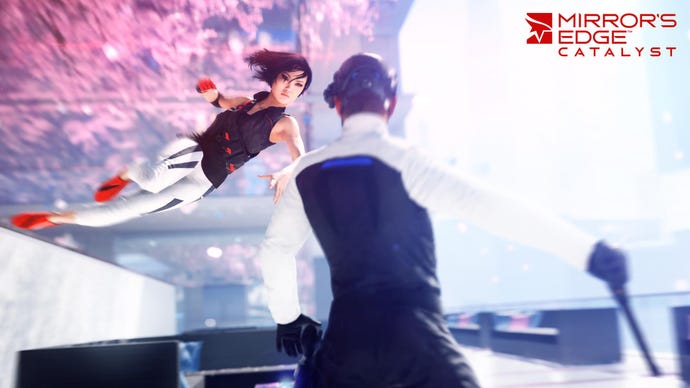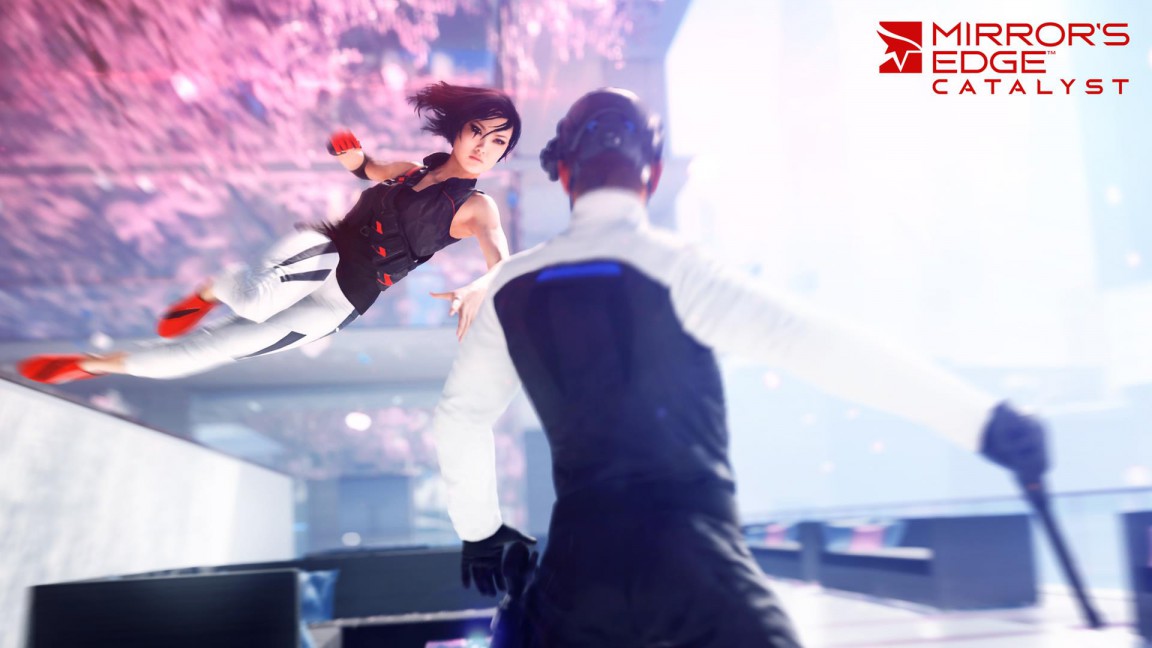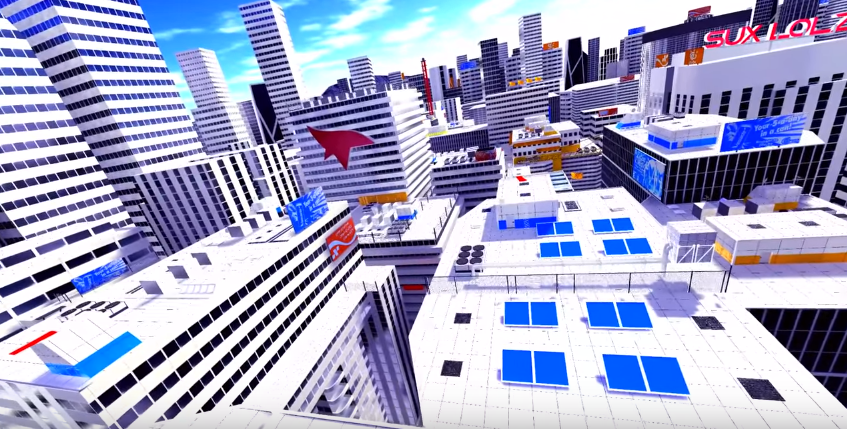Mirror's Edge Catalyst review: the same mistakes, 7 years later
The most disappointing release of 2016 so far?
"It’s almost as if the game doesn’t realise that its quietest moments are its best. More than any cutscene, audiolog, or radio message, Catalyst’s story is best communicated through its architecture."
At first glance, it’s easy to assume Mirror’s Edge Catalyst is set a decade or so in the future. The technology seems close enough: aerial drones; augmented reality contact lenses; voice-activated consoles that characters still have trouble getting to recognise their voice. The truth is, that decade could actually be closer to a century or more.
Catalyst has gone what I like to call "full cyberpunk", presenting a city called Glass ruled by a corporatocracy called The Conglomerate, which itself was born from a failed socialist utopia called OmniStat. Its citizens are divided into "loCaste", "midCaste", and "hiCaste" classes – and that camel case isn’t a typo. Characters wax lyrical about "beatLinks" and "gridNodes" while decrying The Conglomerate’s influence over daily life.
Amidst this jargon, Catalyst’s setting comes across less as the techno-dystopia it thinks it is, and more an obnoxious Silicon Valley pipedream. Imagine if, one year, nobody told the attendees at CES that the convention was over, and an entire society began to grow out from it. That’s the city of Glass. I kept expecting its many pristine ventilation shafts to read "designed in California".
The problem is that, as Catalyst’s rebellious protagonist Faith, you spend less than 30 seconds in this society before being whisked off-the-grid and back into your old life as a runner – a courier of sensitive information. Faith spends more time being told how terrible life under The Conglomerate is than experiencing it first-hand, and it’s couched in such nonsense cyber-babble that, try as one might, it’s hard to find a relatable in-point to these characters’ struggles.
The primary plot is proper sinister, but it throws so much at the wall that nothing sticks – there’s kidnapping, brainwashing, drugging, mistaken identities, even a mysterious cyber-ninja. It’s more muddled than Metal Gear. Most of this plot is advanced with dialogue delivered as earpiece voiceover while Faith is trying to concentrate on navigating a complex, intricate traversal puzzle with her sweet parkour skills.
It’s near impossible to pay attention to both – and honestly, the reason I’m here is for Faith’s fantastic freerunning. She can vault, flip, wall-run, slide, duck and tumble, and scurry up and along almost any surface in Glass’ open world. Her physical skillset is incredibly satisfying to explore and employ, because her movements are cushioned by a good amount of assistance, yet still reward precise timing with faster traversal. Glowing pickups litter the world in an attempt to encourage exploration, but they’re hardly necessary; the world is one giant obstacle course, and simply looking at a building and figuring out how to get to the top of it feels intrinsically rewarding.
This hub is dotted with short time trials, created both by Catalyst’s developers, and by other players. It’s possible to design your own time trial by simply running the route and choosing where to place checkpoints, then have this propagate this onto your friends’ maps. Catalyst sets itself up as an infinite time trial generator, and everything is there for it to happen except for one crucial factor: even ground. Faith can upgrade her parkour abilities by completing missions. Some of these upgrades just make her flat-out faster in certain situations than she was before. Even the game’s loading screen tips recommend unlocking all of Faith’s abilities before attempting to compete in time trials. It’s a non-issue once you have done so, but this takes hours – and some movement upgrades are locked until certain points in the story are reached.
To progress that story, Faith scampers back and forth across Glass to meet various characters and pick up missions. Taking place in intricate high-rise complexes, construction sites, underground facilities, and glistening corporate offices, these missions contrast the non-linear rooftop hub with highly linear, complex, and scripted set pieces. For the most part, these missions are enjoyable, in that they allow Faith to explore intricately crafted areas with often breathtaking architecture accentuated by Catalyst’s vivid artistic direction.
Where it all begins to fall apart is in the game’s combat. The first Mirror’s Edge game suffered because Faith was constantly being shot at, and Catalyst initially sets up brilliant solutions to the problem. The majority of enemies in the first half of the game wield melee weapons, and Faith can chain her parkour abilities directly into attacks to knock these guys out quickly. It’s satisfying because it’s a low-pressure situation; there is ample time to assess the threat, and the surrounding environment, before using the latter to eliminate the former.
By the second half of the game, Catalyst falls back into the exact same habits that crippled its predecessor. Its rooms flood with machine gun-toting goons (or worse – automated defense turrets) that punish platforming failure with death. It’s not fun.
Faith has an ability called Focus Shield which is ostensibly designed for such situations – if she chains enough parkour moves together, she’ll enter a flow state whereby bullets cannot hit her as long as she keeps moving. In early combat encounters, this works fantastically; Faith has time to skirt the edges of the level and build her Focus Shield up before zipping from enemy to enemy and taking them out with traversal attacks.
"By the second half of the game, Catalyst falls back into the exact same habits that crippled its predecessor. Its rooms flood with machine gun-toting goons that punish platforming failure with death. It’s not fun."
However, in later levels, scripted encounters pit Faith against overwhelming odds, often in small arenas that make seamless parkour chains frustratingly difficult. Because her Focus Shield meter resets upon getting clipped by a bullet, or hit with a riot baton, there’s little opportunity to reach that flow state. In some cases, Faith can outrun enemies entirely, but it’s unclear when that’s possible and often takes death after death to figure out. At other times, the game won’t progress until Faith has knocked everyone out. The majority of Catalyst’s back half is soured with such situations.
One might argue that you need lots of enemies with big guns to heighten tension and drama as the plot reaches its conclusion, but then I’d argue you don’t have much of an imagination. Mirror’s Edge doesn’t need bullets whizzing past your head, or the walls and floor exploding around you, to be exciting – and yet, that’s what is happening by Catalyst’s conclusion.
It’s almost as if the game doesn’t realise that its quietest moments are its best. More than any cutscene, audiolog, or radio message, Catalyst’s story is best communicated through its architecture. The city of Glass is divided by caste, with distinct zones unlocked as the story progresses which house the mid, lower, and upper classes. You’ll go from commercial high-rises, to abandoned underground tunnels, to ritzy seaside residences. Taking the time to stop and absorb the sights sells you on the world better than any ruminations on corporate greed run amok.
This physical space, this ground Faith spends her life running over, is what matters. Because of this, Catalyst’s most emotional moment isn’t when a character is in danger, or a sinister scheme is revealed. Instead, it’s the first time Faith sees a tree: it’s lush, green, alive. The moment only lasts seconds, but you share in her awe, because you realise you’ve just been playing for twelve hours and haven’t seen a single tree in the rest of the city of Glass either. That is a future I would run far away from.













